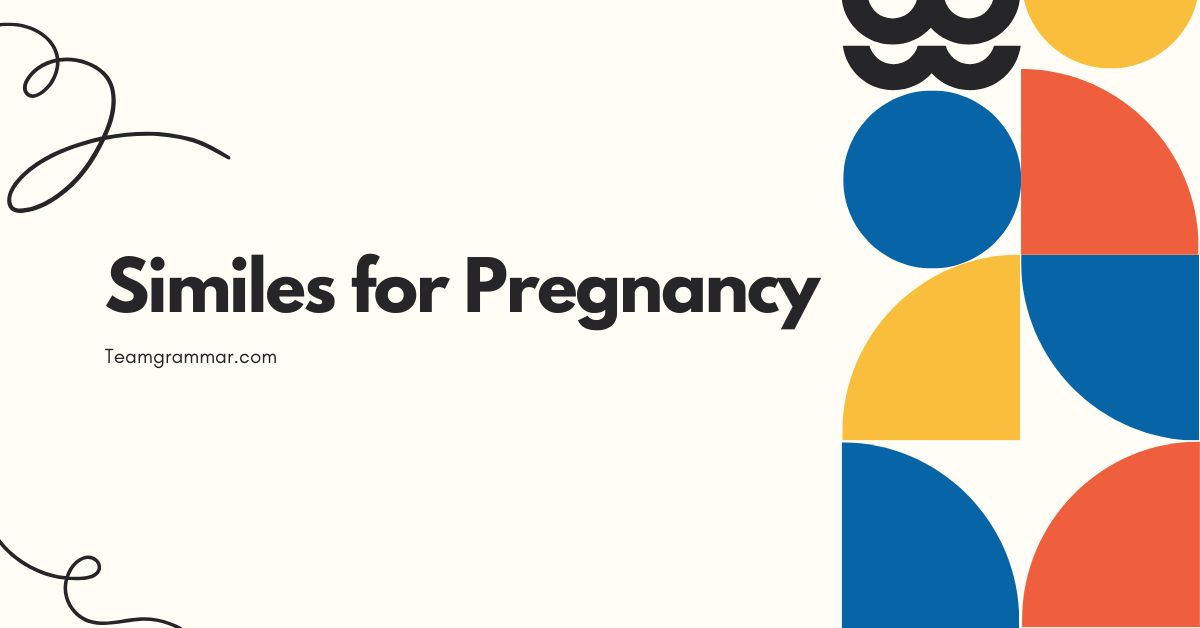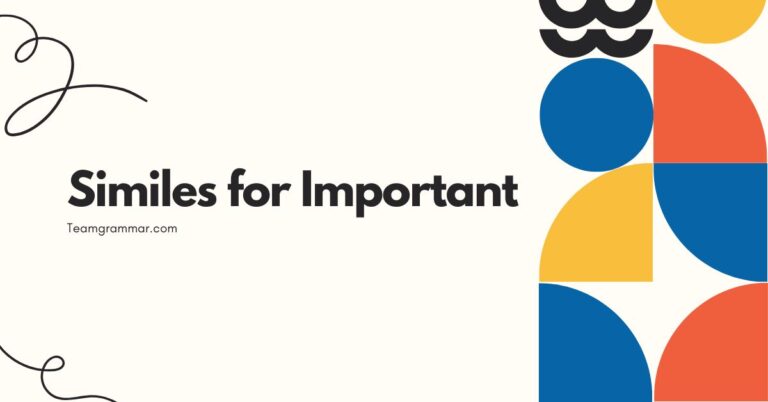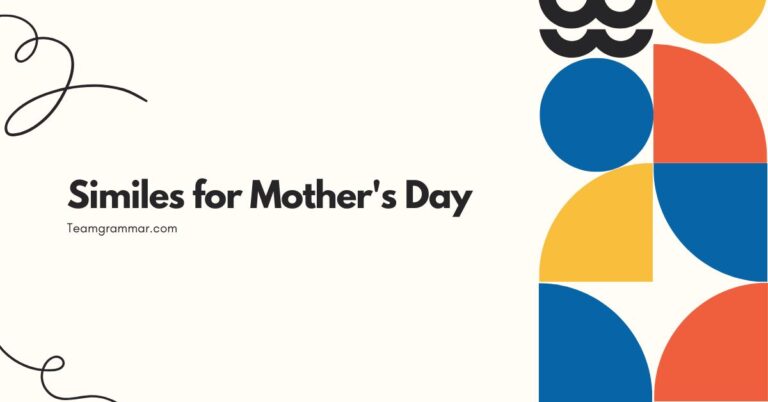27 Similes for Pregnancy: A Grammatical Exploration
Pregnancy, a transformative journey, often inspires vivid and expressive language. Similes, figures of speech that compare two unlike things using “like” or “as,” are particularly effective in conveying the unique sensations, emotions, and physical changes associated with this period.
Understanding how similes function and how they are applied to describe pregnancy enhances both our appreciation of language and our empathy for the experience itself. This article provides a comprehensive guide to pregnancy-related similes, exploring their structure, usage, and impact.
This guide is valuable for English language learners, writers seeking evocative descriptions, and anyone interested in the intersection of language and life experiences.
By exploring this topic, readers will gain a deeper understanding of how figurative language works, enriching their comprehension and communication skills. This article caters to a wide audience, including students, writers, and anyone interested in the beauty and power of the English language.
Learning about similes in the context of pregnancy provides a unique lens through which to examine both linguistic techniques and the human experience.
Table of Contents
- Introduction
- Definition of Simile
- Structural Breakdown
- Types and Categories of Pregnancy Similes
- Examples of Pregnancy Similes
- Examples Describing Physical Changes
- Examples Describing Emotional States
- Examples Describing the Overall Experience
- Usage Rules for Similes
- Common Mistakes with Similes
- Practice Exercises
- Advanced Topics in Simile Construction
- Frequently Asked Questions
- Conclusion
Definition of Simile
A simile is a figure of speech that directly compares two unlike things using the words “like” or “as.” The purpose of a simile is to create a vivid image or convey a deeper understanding of one thing by associating it with another. Similes are a fundamental tool in descriptive writing and are frequently used in both poetry and prose to enhance the reader’s experience and understanding.
Classification
Similes are classified as figures of speech, specifically belonging to the category of figurative language. They are distinct from metaphors, which imply a direct equivalence between two things without using “like” or “as.” For example, “She is *like* a rose” is a simile, whereas “She *is* a rose” is a metaphor.
Similes can also be categorized based on the type of comparison they make, such as comparisons of size, shape, emotion, or experience.
Function
The primary function of a simile is to make writing more descriptive and engaging. By drawing a comparison between two unlike things, similes help readers visualize and understand the subject more clearly.
They can also evoke emotions, create a specific mood, and add depth to the writer’s message. In the context of pregnancy, similes can be used to express the physical discomfort, emotional changes, and profound experiences associated with carrying a child.
Contexts
Similes are used in a wide range of contexts, from everyday conversation to formal literature. They are common in poetry, where their evocative power can enhance the emotional impact of the verse.
In prose, similes can add color and detail to descriptions, making the writing more engaging. Similes are also frequently used in advertising and marketing to create memorable and persuasive messages.
Understanding the context in which a simile is used is crucial for interpreting its meaning and appreciating its effect.
Structural Breakdown
A simile typically consists of three key components: the **subject** (the thing being described), the **linking word** (“like” or “as”), and the **object of comparison** (the thing to which the subject is being compared). The structure can be represented as: Subject + Linking Word + Object of Comparison.
The effectiveness of a simile depends on the clarity and relevance of the comparison. A well-constructed simile creates a strong connection between the subject and the object, enhancing the reader’s understanding and appreciation.
For example, in the simile “Her belly was as round as a basketball,” “her belly” is the subject, “as” is the linking word, and “a basketball” is the object of comparison. This structure allows for a clear and concise comparison that effectively conveys the shape and size of the pregnant belly.
Types and Categories of Pregnancy Similes
Pregnancy similes can be categorized based on what aspect of the experience they aim to describe. These categories include physical changes, emotional states, and the overall experience of pregnancy.
Each category captures different facets of pregnancy, providing a comprehensive view of this transformative period.
Describing Physical Changes
This category includes similes that describe the various physical changes a woman experiences during pregnancy, such as the growing belly, swollen ankles, and changes in skin and hair. These similes often focus on size, shape, and texture to convey the physical transformations occurring in the body.
Examples include: “Her ankles were like balloons” (describing swelling), “Her belly grew like a watermelon” (describing the growing size), and “Her skin was as radiant as the morning sun” (describing changes in skin tone).
Describing Emotional States
Pregnancy is often accompanied by a wide range of emotions, from joy and excitement to anxiety and fear. Similes in this category capture the intensity and variability of these emotional states.
They can also describe the hormonal fluctuations that contribute to mood swings.
Examples include: “Her mood swings were like a rollercoaster” (describing unpredictable emotions), “She felt as happy as a lark” (describing joy), and “Her anxiety was like a dark cloud” (describing worry).
Describing the Overall Experience
This category encompasses similes that describe the overall experience of pregnancy, including the anticipation, the physical discomfort, and the profound connection with the developing baby. These similes often reflect the unique and transformative nature of pregnancy.
Examples include: “Pregnancy felt like a marathon” (describing endurance), “Her connection with the baby was like a lifeline” (describing profound connection), and “Waiting for the baby was like waiting for Christmas” (describing anticipation).
Examples of Pregnancy Similes
Here are numerous examples of similes used to describe various aspects of pregnancy, categorized for clarity. These examples are intended to provide inspiration and illustrate the diverse ways in which similes can be used to convey the experience of pregnancy.
Examples Describing Physical Changes
The following table provides examples of similes that vividly describe the physical changes experienced during pregnancy. Each simile uses “like” or “as” to create a comparison that enhances understanding and imagery.
| Simile | Description |
|---|---|
| Her belly was as round as a basketball. | Describes the shape and size of the pregnant belly. |
| Her ankles were like swollen balloons. | Depicts the swelling often experienced in the ankles. |
| Her breasts felt like heavy stones. | Conveys the increased weight and tenderness of breasts. |
| Her skin glowed like a polished pearl. | Illustrates the radiant complexion associated with pregnancy. |
| Her hair was as thick as a lion’s mane. | Describes the increased hair volume during pregnancy. |
| Her back ached like an old, rusty hinge. | Conveys the discomfort and pain of backaches. |
| Her feet felt like blocks of wood. | Describes the numbness and swelling in the feet. |
| Her face was as flushed as a summer rose. | Depicts the increased blood flow and warmth in the face. |
| Her veins stood out like blue rivers. | Describes the increased prominence of veins. |
| Her movements were as slow as a turtle’s pace. | Conveys the reduced mobility due to pregnancy. |
| She waddled like a penguin. | Describes the typical gait of a pregnant woman. |
| Her breath came as heavy as a sigh. | Conveys the shortness of breath experienced during pregnancy. |
| Her hands were as puffy as marshmallows. | Depicts the swelling in the hands. |
| Her legs felt like lead weights. | Describes the heaviness and fatigue in the legs. |
| Her stomach felt as tight as a drum. | Conveys the stretched and taut feeling of the belly. |
| Her complexion was like a clear, blue sky. | Illustrates the radiant complexion associated with pregnancy. |
| Her nails grew as fast as weeds. | Describes the accelerated nail growth during pregnancy. |
| Her appetite was like a bottomless pit. | Conveys the increased hunger and cravings. |
| Her sleep was as light as a feather. | Describes the difficulty of sleeping soundly. |
| Her skin stretched like a rubber band. | Depicts the stretching of the skin on the belly. |
| Her breasts were as tender as a bruise. | Conveys the tenderness and sensitivity of breasts. |
| Her gums bled like a leaky faucet. | Describes the increased sensitivity and bleeding of gums. |
| Her vision was as blurry as looking through fog. | Conveys the temporary vision changes during pregnancy. |
| Her body felt like a temple. | Describes the reverence and care for her body. |
| Her heart beat as strong as a drum. | Conveys the increased blood volume and heart rate. |
These similes offer vivid descriptions of the physical transformations that occur during pregnancy, helping readers understand and empathize with the experience.
Examples Describing Emotional States
The emotional landscape of pregnancy can be complex and varied. The following table provides examples of similes that capture the range of emotional states experienced during this time.
These similes use “like” or “as” to draw comparisons that highlight the intensity and variability of these emotions.
| Simile | Description |
|---|---|
| Her mood swings were like a rollercoaster. | Describes the unpredictable and rapid changes in emotions. |
| She felt as happy as a lark. | Conveys a sense of joy and elation. |
| Her anxiety was like a dark cloud. | Depicts the feeling of worry and apprehension. |
| She was as excited as a child on Christmas morning. | Illustrates the anticipation and joy of expecting a baby. |
| Her fears were like monsters under the bed. | Describes the lurking and persistent anxieties. |
| She felt as vulnerable as a newborn chick. | Conveys a sense of fragility and sensitivity. |
| Her love for the baby was like a warm blanket. | Describes the comforting and nurturing feeling of love. |
| Her patience wore as thin as paper. | Depicts the frustration and irritability. |
| She felt as overwhelmed as a student facing finals. | Conveys the feeling of being burdened by responsibilities. |
| Her sadness was like a gentle rain. | Describes a quiet and pervasive feeling of melancholy. |
| She was as sensitive as a flower petal. | Depicts the heightened emotional sensitivity. |
| Her joy bubbled like a champagne fountain. | Conveys a sense of effervescent happiness. |
| Her worries felt like a tangled thread. | Describes the feeling of being caught in a web of anxieties. |
| She felt as powerful as a lioness. | Illustrates the strength and protective instincts. |
| Her emotions were as turbulent as a stormy sea. | Depicts the intensity and instability of feelings. |
| She felt as peaceful as a sleeping baby. | Conveys a sense of serenity and contentment. |
| Her intuition was like a guiding star. | Describes the strong sense of knowing and understanding. |
| Her hope was as bright as the morning sun. | Illustrates the optimism and anticipation. |
| She felt as connected as two peas in a pod. | Conveys the deep bond with the unborn child. |
| Her anticipation was like a tightly wound spring. | Describes the pent-up excitement and eagerness. |
| Her gratitude was as deep as the ocean. | Conveys a profound sense of thankfulness. |
| She felt as radiant as a bride. | Illustrates the joy and beauty of expecting a child. |
| Her resolve was like a steel beam. | Describes the strength and determination. |
| She felt as blessed as an angel. | Conveys a sense of divine favor and gratitude. |
| Her love grew like a blooming garden. | Illustrates the expanding and flourishing affection. |
These similes effectively capture the diverse emotional experiences of pregnancy, providing a deeper understanding of the emotional journey.
Examples Describing the Overall Experience
Pregnancy is a unique and transformative experience. The following table provides examples of similes that describe the overall experience of pregnancy, capturing the anticipation, challenges, and profound connections associated with this period.
These similes use “like” or “as” to create comparisons that highlight the unique nature of pregnancy.
| Simile | Description |
|---|---|
| Pregnancy felt like a marathon. | Describes the endurance and stamina required. |
| Her connection with the baby was like a lifeline. | Conveys the profound and essential bond. |
| Waiting for the baby was like waiting for Christmas. | Illustrates the anticipation and excitement. |
| Pregnancy was like a journey to an unknown land. | Describes the unfamiliar and transformative nature. |
| Her body felt like a vessel carrying precious cargo. | Conveys the responsibility and care for the developing baby. |
| Pregnancy felt as surreal as a dream. | Describes the sense of unreality and wonder. |
| Her life felt like it was on pause. | Conveys the sense of waiting and anticipation. |
| Pregnancy was like watching a flower bloom in slow motion. | Illustrates the gradual and beautiful development. |
| Her heart felt like it was expanding to make room for the baby. | Describes the growing love and connection. |
| Pregnancy felt as heavy as carrying the weight of the world. | Conveys the physical and emotional burden. |
| Her body was like a garden nurturing new life. | Describes the nurturing and life-giving role of the body. |
| Pregnancy felt as miraculous as a sunrise. | Illustrates the wonder and awe of creating life. |
| Her world felt like it had shrunk to the size of her womb. | Conveys the intense focus on the baby. |
| Pregnancy was like climbing a mountain, one step at a time. | Describes the challenges and gradual progress. |
| Her days felt as long as years. | Conveys the slow passage of time due to anticipation. |
| Pregnancy felt as natural as breathing. | Illustrates the innate and instinctive nature. |
| Her instincts were as sharp as a predator’s. | Describes the heightened protective instincts. |
| Pregnancy was like a dance between two souls. | Conveys the intimate and connected relationship. |
| Her body felt as strong as a fortress. | Illustrates the resilience and protective strength. |
| Pregnancy felt as transformative as a caterpillar becoming a butterfly. | Describes the profound personal growth and change. |
| Her anticipation was like a drumbeat in her heart. | Conveys the persistent and rhythmic excitement. |
| Pregnancy felt as sacred as a religious ritual. | Illustrates the reverence and respect for creating life. |
| Her identity felt like it was being reshaped. | Describes the profound changes in self-perception. |
| Pregnancy was like a symphony of hormonal changes. | Conveys the complex and harmonious processes. |
| Her life felt as full as a bursting balloon. | Illustrates the overflowing joy and anticipation. |
These similes provide a comprehensive overview of the pregnancy experience, capturing its various dimensions and nuances.
Usage Rules for Similes
To effectively use similes, it’s important to adhere to certain guidelines. These rules ensure that the similes are clear, relevant, and impactful.
Clarity and Relevance
The comparison made in a simile should be clear and easy to understand. The object of comparison should be something familiar to the reader, and the connection between the subject and object should be logical and relevant.
Avoid using obscure or confusing comparisons that may detract from the message.
For example, “Her belly was as round as the moon” is clear and relevant because the moon’s roundness is a common and easily understood image. However, “Her belly was as round as a dodecahedron” would be less effective because a dodecahedron is not a familiar shape to most people.
Originality
While some common similes can be effective, striving for originality can make your writing more engaging and memorable. Try to come up with unique comparisons that offer a fresh perspective on the subject.
Avoid clichés and overused similes that may sound stale or uninspired.
Instead of saying “She was as happy as a clam,” try something more original like “She was as happy as a child discovering a hidden treasure.” The latter is more specific and evocative.
Cultural Sensitivity
Be mindful of cultural differences and sensitivities when using similes. A comparison that is meaningful and appropriate in one culture may be offensive or confusing in another.
Consider your audience and the potential impact of your words.
For example, a simile that references a specific cultural symbol or tradition may not be understood by readers from different backgrounds. It’s important to ensure that your similes are inclusive and respectful.
Common Mistakes with Similes
Several common mistakes can undermine the effectiveness of similes. Recognizing and avoiding these errors will help you use similes more confidently and skillfully.
| Mistake | Incorrect Example | Correct Example | Explanation |
|---|---|---|---|
| Using metaphors instead of similes | Her belly was a watermelon. | Her belly was like a watermelon. | A metaphor directly equates two things, while a simile uses “like” or “as” for comparison. |
| Creating unclear comparisons | Her mood was like Tuesday. | Her mood was like a stormy sea. | The comparison should be easily understood and relevant. |
| Using clichés | She was as happy as a clam. | She was as happy as a child on Christmas morning. | Avoid overused similes that lack originality. |
| Creating illogical comparisons | Her feet were as light as stones. | Her feet were as heavy as stones. | The comparison should make logical sense. |
| Using too many similes in close proximity | Her eyes were like stars, her hair like silk, her smile like sunshine. | Her eyes were like stars, and her smile radiated sunshine. | Avoid overwhelming the reader with too many similes. |
| Using culturally insensitive comparisons | (Example varies depending on cultural context) | (Revised example to avoid offense) | Be mindful of cultural differences and sensitivities. |
| Using mixed metaphors and similes | She was a rock, as soft as a feather. | She was as strong as a rock, but also as sensitive as a feather. | Maintain consistency in your figurative language. |
Avoiding these common mistakes will help you use similes more effectively and enhance the quality of your writing.
Practice Exercises
These exercises will help you practice identifying, completing, and creating similes. Each exercise focuses on different aspects of simile usage and construction.
Exercise 1: Identifying Similes
Identify the similes in the following sentences. Underline the simile and identify the two things being compared.
| Question | Answer |
|---|---|
| 1. Her belly was as round as a beach ball. | as round as a beach ball (belly, beach ball) |
| 2. She felt like she was carrying the weight of the world. | like she was carrying the weight of the world (she, carrying the weight of the world) |
| 3. Her mood swings were like a rollercoaster ride. | like a rollercoaster ride (mood swings, rollercoaster ride) |
| 4. She was as radiant as the morning sun. | as radiant as the morning sun (she, morning sun) |
| 5. Her feet felt like blocks of ice. | like blocks of ice (feet, blocks of ice) |
| 6. She was as patient as a saint. | as patient as a saint (she, saint) |
| 7. Waiting felt like an eternity. | like an eternity (waiting, eternity) |
| 8. Her skin glowed like a polished pearl. | like a polished pearl (skin, polished pearl) |
| 9. The baby’s kicks felt like gentle taps. | like gentle taps (baby’s kicks, gentle taps) |
| 10. She was as nervous as a cat in a room full of rocking chairs. | as nervous as a cat in a room full of rocking chairs (she, cat in a room full of rocking chairs) |
Exercise 2: Completing Similes
Complete the following similes with an appropriate comparison.
| Question | Answer |
|---|---|
| 1. Her belly was as big as ______. | Her belly was as big as a watermelon. |
| 2. She felt as tired as ______. | She felt as tired as a marathon runner. |
| 3. Her cravings were like ______. | Her cravings were like a powerful magnet. |
| 4. She was as excited as ______. | She was as excited as a child opening presents. |
| 5. Her ankles were as swollen as ______. | Her ankles were as swollen as balloons. |
| 6. Her skin was as smooth as ______. | Her skin was as smooth as silk. |
| 7. Her patience was as thin as ______. | Her patience was as thin as paper. |
| 8. Her love was as deep as ______. | Her love was as deep as the ocean. |
| 9. Her body felt like ______. | Her body felt like a temple. |
| 10. Waiting felt like ______. | Waiting felt like an eternity. |
Exercise 3: Creating Similes
Create your own similes to describe the following aspects of pregnancy.
| Topic | Example Simile |
|---|---|
| 1. Morning sickness | Morning sickness felt like a never-ending storm in her stomach. |
| 2. The first kick | The first kick felt like a butterfly fluttering its wings inside her. |
| 3. Labor pains | Labor pains were like waves crashing against the shore, each one stronger than the last. |
| 4. The baby’s room | The baby’s room was as peaceful as a quiet meadow. |
| 5. Holding the newborn | Holding the newborn felt like holding a piece of heaven. |
| 6. The exhaustion | The exhaustion was like a heavy cloak she couldn’t take off. |
| 7. The joy | The joy was as bright as a thousand suns. |
| 8. The connection with the baby | Her connection with the baby was like an invisible thread. |
| 9. The changes in her body | The changes in her body were like a landscape being reshaped. |
| 10. The anticipation | The anticipation was as palpable as the air before a thunderstorm. |
These exercises provide a practical way to improve your understanding and use of similes in describing pregnancy.
Advanced Topics in Simile Construction
For advanced learners, exploring more complex aspects of simile construction can further enhance their writing skills. These topics include extended similes and complex comparisons.
Extended Similes
An extended simile is a simile that is developed over several sentences or even paragraphs. Instead of a brief comparison, an extended simile explores the similarities between the subject and object in greater detail, creating a richer and more nuanced image.
For example: “Pregnancy was like a long and challenging hike up a mountain. Each day brought new obstacles and discomforts, like steep inclines and rocky terrain.
Yet, with each step, she grew stronger and more determined, like a seasoned climber pushing towards the summit. The anticipation of reaching the top, of holding her baby in her arms, fueled her onward, just as the promise of a breathtaking view motivates a hiker to persevere.”
Complex Comparisons
Complex comparisons involve using similes to compare abstract concepts or ideas. These comparisons require a deeper understanding of both the subject and object and the ability to draw connections between seemingly unrelated things.
For example: “The bond between a mother and her child is like a complex algorithm, a series of interconnected codes and responses that create a unique and unbreakable connection. Each interaction, each touch, each shared moment adds another layer to the algorithm, strengthening the bond and creating a deep and lasting relationship.”
Mastering these advanced techniques can elevate your writing and allow you to create more sophisticated and impactful similes.
Frequently Asked Questions
Here are some frequently asked questions about similes, particularly in the context of describing pregnancy.
- What is the difference between a simile and a metaphor?
A simile compares two unlike things using “like” or “as,” while a metaphor directly equates them without using these words. For example, “She is like a rose” is a simile, while “She is a rose” is a metaphor. Metaphors imply a stronger sense of equivalence, while similes suggest a similarity.
- Why are similes useful in describing pregnancy?
Similes provide a vivid and relatable way to describe the physical and emotional changes of pregnancy. They help readers understand and empathize with the experience by comparing it to familiar things.
- How can I avoid using clichés when creating similes?
To avoid clichés, try to think of unique and specific comparisons that offer a fresh perspective. Brainstorm different objects, ideas, or experiences that share a common characteristic with the subject you are describing. The more specific and original your comparison, the more engaging your simile will be.
- Is it better to use “like” or “as” in a simile?
Both “like” and “as” can be used effectively in similes. “Like” is generally used to compare nouns or pronouns, while “as” is used to compare clauses or phrases. However, the choice often comes down to personal preference and the rhythm of the sentence.
- Can I use similes in formal writing?
Yes, similes can be used in formal writing, but it’s important to use them sparingly and appropriately. Ensure that the similes are clear, relevant, and enhance the overall message. Avoid using overly casual or colloquial comparisons in formal contexts.
- How can I make my similes more impactful?
To make your similes more impactful, focus on creating a strong and vivid connection between the subject and object. Use sensory details and evocative language to bring the comparison to life. Consider the emotional impact of the simile and choose comparisons that resonate with the reader.
- What if my reader doesn’t understand the comparison in my simile?
If you suspect that your reader may not understand the comparison, consider providing additional context or explanation. You can also choose a different comparison that is more familiar or accessible to your audience. Clarity is essential for effective communication.
- How many similes should I use in a piece of writing?
There is no set limit to the number of similes you can use, but it’s important to avoid overuse. Too many similes can overwhelm the reader and detract from the overall message. Use similes strategically to enhance your writing and add depth to your descriptions.
- Can similes be used to describe negative aspects of pregnancy?
Yes, similes can effectively describe the negative aspects of pregnancy, such as discomfort, pain, and anxiety. These similes can help convey the challenges and difficulties associated with pregnancy, fostering empathy and understanding.
- Are there any cultural considerations when using similes to describe pregnancy?
Yes, it’s important to be mindful of cultural differences and sensitivities when using similes. Some comparisons may be more relevant or appropriate in certain cultures than others. Avoid using similes that could be offensive or insensitive to your audience.
Conclusion
Mastering the use of similes can significantly enhance your descriptive writing, particularly when conveying the complex and multifaceted
experience of pregnancy. By understanding the structure, types, and usage rules of similes, you can create vivid and impactful comparisons that resonate with your audience.
Whether you’re describing physical changes, emotional states, or the overall journey, similes offer a powerful tool for bringing the experience of pregnancy to life. Practice the exercises provided, explore advanced techniques, and always be mindful of clarity, originality, and cultural sensitivity.
With these skills, you’ll be well-equipped to use similes effectively and enrich your writing with depth and nuance.







